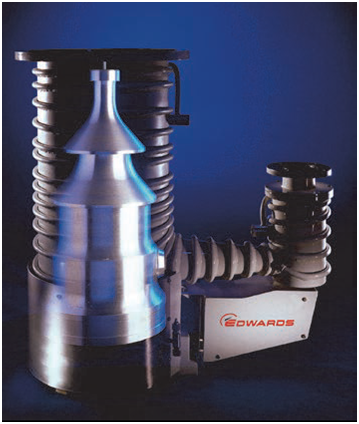Edwards’ vapour pumps suit the widest range of applications, as weoffer the most comprehensive range of pumps and accessories available from any supplier.Our industrial, high throughput diffusion pumps and vapour boosterpumps fulfil the requirements of applications like vacuum metallurgy,distillation and coating.Our compact scientific pumps are designed for instrument and general R&D applications.By matching the pump of your choice with appropriate accessories,we offer a complete high vacuum pumping solution for allapplications.
Pumping Speed and Throughput
The pumping speed (volume flowrate) of a vapour pump is thevolume of gas and vapour passing through the inlet of the pump in one second. The unit of measurement is l s-1. The throughput (massflowrate) is the mass of gas passing through the pump in one secondand is measured in mbar l s-1. The throughput of the pump is thesame at the pump inlet and pump outlet.At a given pressure, pumping speed (S) and throughput (Q) arerelated by the simple equation: Q = P × S, where P is the pressure.You can use this equation to convert between pumping speed andthroughput measurements.Below about 1 × 10-3 mbar, pumping speed is the most convenientmeasure of the pump’s performance. At these pressures, thepumping speed is proportional to the diameter of the pump inlet: alarge pump is required to obtain higher pumping speeds. Above about1 × 10-3 mbar, the pump’s throughput is most often used tocharacterise its performance. At these pressures, the performance ofthe pump is affected by its internal construction as well as its overallsize.To choose the best type of vapour pump for your application, youmust define the operation pressure and the pumping speed (orthroughput) requirement of your application and match these to theperformance characteristics of our range of vapour pumps.Remember that, when you calculate the required pumping speed, you must include provision for the process gas throughput, the out gassing of the vacuum system and the leakage into the system. You may also have to consider how quickly you want to achieve the operation pressure.
Measurement Methods
The methods used to measure pressure and flow have become more accurate in recent years allowing much tighter controls over system conditions. The speeds and through puts quoted in the catalogue for the HT diffusion pumps are based on actual pump data derived from measurements made with the latest technology total pressure gauges and mass flow transducers in accordance with ISO standards.Some confusion could arise with previously published speed and throughput figures for older designed pumps where, historically,pressure measurements were made with partial pressure gauges likethe McLeod gauge. This older gauge can indicate speeds up to 30%higher than that expected using state of the art total pressure gauges.Further confusion could arise from the measurement standardschosen to determine pumping performance. In the case of AVS(American Vacuum Society), this can indicate speeds and throughputup to 15% higher than ISO figures.Historical industry practice meant that in considering the above, and potential gauge accuracy of ± 15%, it was possible to have speedsquoted 60% higher than might be expected using modern total pressure measurement equipment. This should be carefullyconsidered when comparing specifications for older derived data published for similarly sized competitor pumps and the Edwards HTdiffusion pumps.
Ultimate Vacuum
The ultimate vacuum of a vapour pump is the lowest pressureachieved in tests on the pump, measured above the inlet of the pump(or above the high vacuum valve for the Diffstaks). The ultimatevacuum depends on: the type of fluid used in the pump; thetemperature of the inlet baffle; the amount of outgassing from thevacuum system; and the amount of leakage into the system.
Critical Backing PressureThe critical backing pressure is the highest pressure that a pump cantolerate in the backing line. If the pressure is higher than the criticalbacking pressure, the pump may stall. The critical backing pressuredepends on: the pump design; the power of the heaters; and the fluidused in the vapour pump.
Backstreaming
Backstreaming is the direct movement of molecules of pump fluidvapour from the pump toward the vacuum system. All Edwards pumps are specially designed to minimise backstreaming; the pumpshave a guard ring (sometimes called a cool-cap) fitted above the topjet. The guard ring condenses vapour molecules moving from the topjet toward the vacuum system.In some sensitive applications, backstreaming may be veryundesirable; you can minimise backstreaming if you fit a baffle or atrap to the top of the pump.
